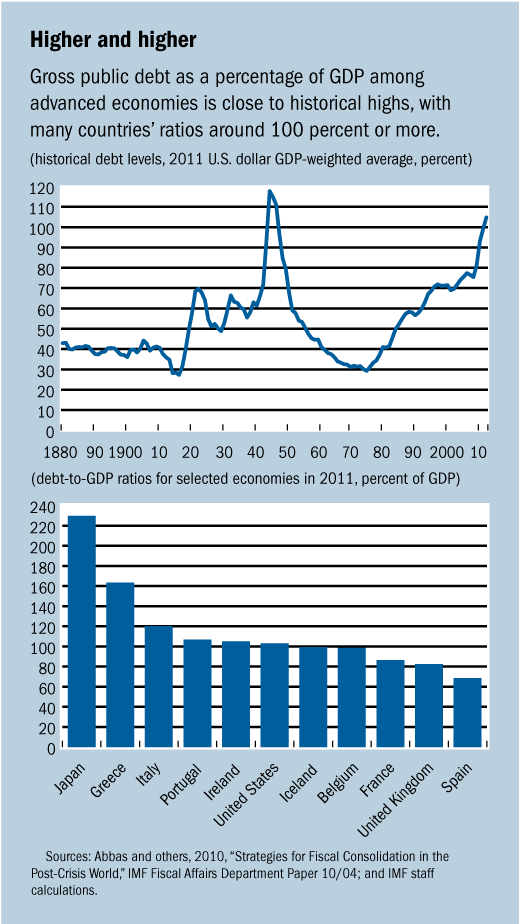WORLD ECONOMIC OUTLOOK
History Offers Tips for Getting a Handle on Public Debt
IMF Survey online - September 27, 2012
- History offers useful lessons for countries struggling with high public debt today
- Debt reduction needs combination of fiscal consolidation, growth-supporting policies
- Public finances require lasting, not temporary, reforms, says new IMF study
Countries battling high public debt must combine policies that support economic growth with lasting changes in government spending and taxation, a new study by the International Monetary Fund (IMF) concludes.

A chapter in the IMF’s World Economic Outlook notes that public debt has surpassed 100 percent of GDP in Japan, the United States, and several European countries in recent years (see chart below). This is especially worrying because of the low growth, persistent budget deficits, and looming liabilities due to aging populations in these countries. A result, particularly in Europe, has been ratings downgrades and higher borrowing costs.
The main IMF forecast for the global economy will be released on October 9 in Tokyo.
There is widespread debate about the best way to reduce public debt. Some advocate strict budgets or fiscal austerity; others, reinvigorating growth through spending, or fiscal stimulus; and still others cite the successful post–World War II U.S. strategy of “financial repression”—governments channeling funds to themselves.
Debt since 1875
The study uses an IMF database dating back to 1875 that identifies 26 episodes of debt exceeding 100 percent in the past. The research looks at the policy responses and outcomes in each case, and draws lessons for countries battling high public debt today.
“Indeed, some of the most instructive episodes were those in which public debt increased,” say the study’s authors.
The report offers three lessons for today, after close examination of six case studies of advanced economies in which public debt exceeded the threshold of 100 percent of GDP, spanning a century of experience. The cases—the United Kingdom (1918), the United States (1946), Belgium (1983), Canada (1995), Italy (1992), and Japan (1997)—cover the two postwar eras and the most recent era of peacetime debt buildup.
Growth-supporting policy complements fiscal consolidation
Lesson 1: Fiscal consolidation must be complemented by policy measures that support growth.
In Japan, weak growth prevented fiscal consolidation. Debt continued to climb until the authorities addressed weaknesses in the banking system and corporate sector that limited the efficacy of monetary policy.
And in Belgium, Canada, and Italy, debt did not fall until monetary conditions were supportive. These countries all implemented large fiscal adjustments. But it was only after real interest rates fell that all three countries were able to reduce their debt. In some cases, reforms to wage-setting mechanisms broke a wage-price spiral. And exchange rate depreciation supported external demand and growth.
The case of the United Kingdom offers a cautionary lesson for countries contemplating internal devaluation today. The U.K. government combined tight monetary policy and severe fiscal austerity to cut the price level and return the pound to prewar parities. The results were disastrous: unemployment increased, growth remained anemic, and debt continued to rise. This shows that a reduction in the price level, a necessary part of internal devaluation, comes at a high cost. But determining whether the cost from internal devaluation is greater than the benefit to competitiveness requires further research.
The U.S. experience in the immediate postwar years confirmed the importance of supportive monetary policy. Limits on nominal interest rates and bursts of inflation quickly reduced the debt ratio, while growth remained strong. But it is unclear whether such financial repression would work for countries facing high debt burdens today. Not only are advanced economies benefiting from historically low sovereign interest rates, but the inflationary consequences of financial repression could threaten the structures that have been in place in recent decades to prevent inflation.
Lasting reforms trump temporary measures
Lesson 2: Debt reduction is larger and more lasting when fiscal measures are permanent.
While Belgium, Canada, and Italy all implemented large fiscal adjustment when low inflation was seen as necessary for economy stability, their success in reducing public debt varied. The greater success of Belgium and Canada was partly attributable to the former countries putting more weight on permanent rather than temporary improvements that were Italy’s preference. And both Belgium and Canada implemented fiscal frameworks in the 1990s that locked in the improvements achieved earlier.
Deficits not easily reversed
Lesson 3: Fiscal repair and debt reduction take time.
Only in postwar periods were deficits quickly reversed. And countries that still have high debt remain vulnerable to subsequent shocks, the study warns. For example, Belgium took 10 years to move from a deficit of 7 percent to a surplus of 4 percent. But even after relative successes, Belgium and Canada suffered sharp increases in public debt after the global financial crisis. And the supportive external environment that facilitated the earlier debt reduction success stories is absent today.
Widespread fiscal cutbacks, retreat by the private sector, population aging, and the aftermath of the financial crisis mean even countries that follow the guidebook will have to moderate their expectations for reducing debt.

